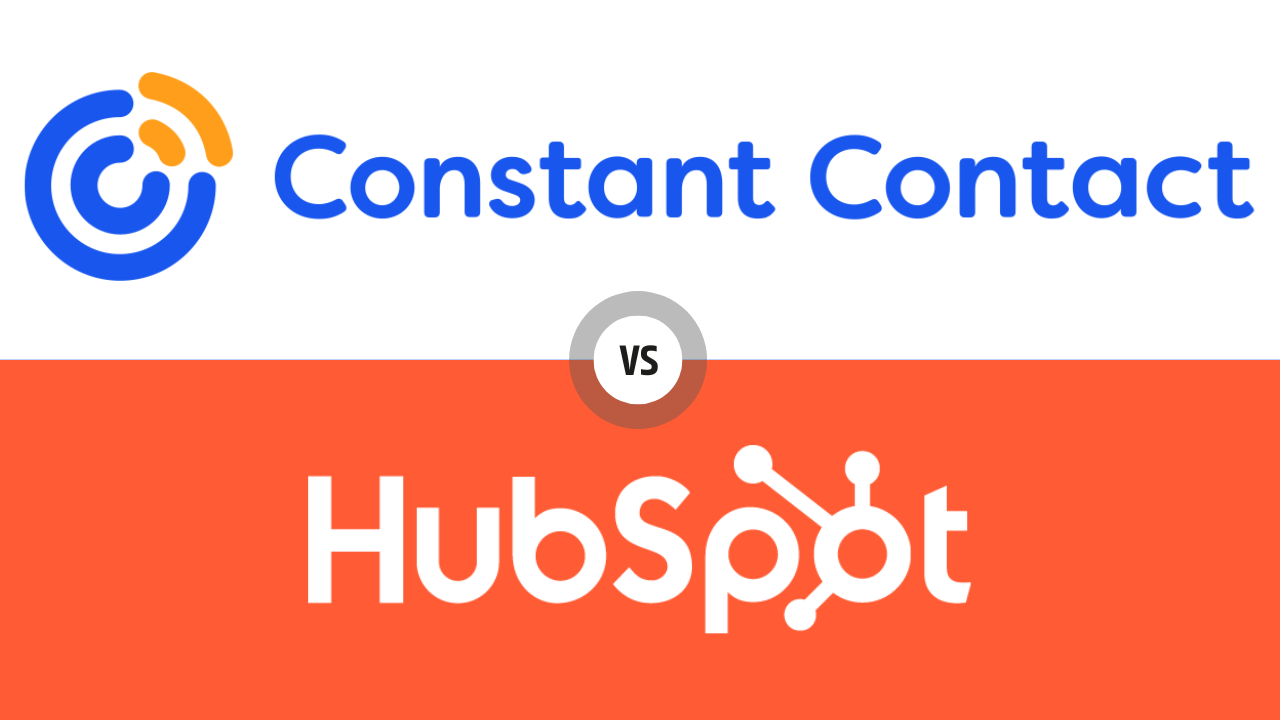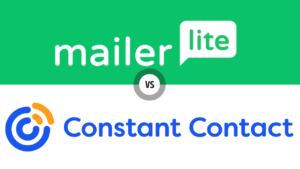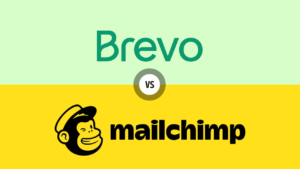Overview of ConstantContact vs HubSpot
Making the choice between ConstantContact and HubSpot for your email marketing and overall marketing strategy might determine how well your digital marketing campaigns perform. This article gives a thorough comparison of ConstantContact vs HubSpot, focusing on aspects like usability, email marketing tools, automation capabilities, CRM connectivity, freedom in template design, and more. This article intends to give you the information you need to make an informed decision, whether you’re a small business owner searching for an easy-to-use email marketing solution or a developing company in need of an all-inclusive marketing platform.
Table of Contents
Ease of Use and User Interface
ConstantContact is known for having a very easy, friendly dashboard. Beginners have an interface with a smooth layout, where all major features are easily accessible. It is easy to navigate through all the activities on the platform, from creating an email campaign to reading reports. This basic nature of ConstantContact is what would make it such a pleasing option for small businesses and people starting in email marketing.
HubSpot would provide sets of tools and services across a much broader span of marketing, sales, and service needs that would be stronger and more relevant. This implies that its interface is much more complex but also really neat. They invested a lot into the user experience, and it has made it pretty easy to access and use their powerful features. The learning curve is steeper than with ConstantContact, but many see the wide range of functionalities as well worth spending time on.


Comparing Constant Contact vs HubSpot in their ease of use, the two offer similar interfaces, with an interface in both platforms that is highly intuitive and easy to use but caters to slightly different user bases. ConstantContact shows up with an easy approach that is perfect for the kind of customer who values simplicity and ease of use in their e-mail marketing field. Despite having a more complicated user interface, HubSpot’s all-inclusive platform caters to those looking for a complete solution that includes more than just email marketing. Both platforms offer a wide range of tools to assist users in familiarizing themselves with their interfaces, resulting in a comparatively seamless onboarding process.
Email Marketing Features
ConstantContact offers an all-in-one email marketing tool aimed at suiting small and mid-sized businesses to create, send, and optimize emails. It offers numerous ready templates that can be altered meaning design skills are not a must for a user to easily design beautiful emails. Together with their list management and segmentation tools, customers can effectively direct communications being able to offer higher rates of engagement and conversions.
On the other hand, HubSpot has a very strong functional offering in email marketing but is far more focused on how tightly it is integrated within its all-in-one marketing platform. HubSpot’s emailing tools formed part of the wider ecosystem, together with CRM, inbound marketing, and analytics, being used to enable hyper-personalized, automated email campaigns based on detailed data about customers’ behavior, personalities, and multi-channel activities. This makes it possible to develop more refined and well-focused strategies, though it may pose a higher learning curve.


Comparing ConstantContact vs HubSpot for email marketing features, it is clear that both platforms hold valuable offerings. An email-only business owner will appreciate ConstantContact, as it is equipped with very easy segmentation, simple email-building tools, and a great template library. The deeper level of integration and automation features in HubSpot makes it suitable for such companies whose use would not only be limited to email marketing but would support an organization in its data-driven approach to comprehensive marketing. With these tools, the two platforms offer A/B testing, deep analytics, and deliverability optimization for marketers.
Automation and Workflow Capabilities
ConstantContact provides some basic automation functionalities that are specific to make it a lot easier for small businesses and individuals who may be beginners in email marketing automation. The welcome emails, re-engagement campaigns, and action-based email series can all be automated at the subscriber’s platform. This allowed users to set up simple yet very functional automated email sequences without the necessary complexities of needing one to be knowledgeable about complex technical underpinnings.
On the other hand, HubSpot provides significantly more powerful automation tools across marketing, sales, and service activities for businesses of every shape and size. Highly customizable workflows will allow the user to design even very complex marketing campaigns because they can adapt based on user behavior, lead scoring, or even sales stage. Email automation doesn’t stop at that point but just easily merges with the rest of the CRM systems to auto-activity within the various marketing, sales, and service hubs.


This comparison of ConstantContact vs Hubspot’s capabilities in automation and workflow shows that they are built for different needs. ConstantContact is a pretty easy solution to use, just perfect for beginners or those looking to automate with more basic needs. HubSpot can be termed as the All-In-One and very highly customizable targeting businesses in need of advanced automation capability across their marketing and sales funnel. Both platforms are designed to save users time and increase efficiency by automating tasks like posting repeatedly, but HubSpot beats ConstantContact for those that have more sophisticated, integrated workflows.
CRM Features and Integration
ConstantContact makes CRM features simplified and easy for all small businesses who wish to have the full power of contact management without the added boredom that comes with bigger CRM systems. This includes basic contact management, segmentation, and tracking within the email marketing platform. While ConstantContact does offer integrations with other software, it does keep its main focus on the improvement of the email marketing process and does not give out the whole CRM solution.
HubSpot, on the other hand, provides a fully integrated CRM platform at its core. Built with the ability to scale businesses as they grow, it offers a scalable feature that encompasses more than just email marketing from the point of lead generation to sales and then to customer service and content management. The key features that Hubspot prides itself on include tracking contact records in more detail, viewing the whole customer’s journey, and automation by managing sales, leads, and the pipeline.
When comparing HubSpot vs. ConstantContact for CRM features and integration, it is clear that HubSpot provides a more comprehensive and all-inclusive solution. It is made to serve businesses looking for a full range of CRM capabilities and seamless interaction between marketing, sales, and customer support initiatives. ConstantContact is a superior choice for people who value simplicity and direct email marketing campaigns as it offers essential CRM features in its email marketing platform. Although connectivity is possible with both platforms, HubSpot is a better option for businesses looking for a single platform to handle client relationships across several touchpoints.
Pricing and Plans Overview
ConstantContact’s pricing starts at a very low entry point. In short, it is a very attractive option for startup businesses and small businesses just starting. It offers a simple tiered pricing structure, with your full package of email marketing tools coming in the basic plan and only increasing in price as you add more contacts. ConstantContact also offers a free trial which allows users of the platform to test how it works before actually implementing it.
HubSpot uses the freemium model, offering free strong CRM to customers in parallel with the basic email marketing tool. This might be the reason why this free level of service continues to be appealing to more startups and small businesses, which have CRM functionality needs but do not have the capital to pour into a costly system. For more advanced features, HubSpot’s pricing goes up in all four “hubs” (Sales, Marketing, Service, and CMS), and for every one of them (Starter, Professional, and Enterprise level), to accommodate ever more mature businesses. Although starting from a higher point with their advanced features than ConstantContact, they have a lot more depth of functionality.


When comparing ConstantContact vs HubSpot in price and plans, both platforms have those covering huge audiences but have different focuses. ConstantContact offers a very simple, contact-based pricing scheme that should be quite appealing to small business users looking for a straightforward, easily budgeted solution while putting the most effort into their email marketing. HubSpot follows a freemium model, starting with a free plan that includes quite a lot of features essential for email marketing. Then, with growing needs in business, the user will transition to an all-in-one comprehensive plan with sales, service, and content management solutions. All of these should add some level of value.
Template and Design Flexibility
ConstantContact has a great variety of templates in its large library, which cover almost everything and are designed for many industries and all occasions. Ready-to-go templates are made so intuitive that even a person with little experience in design or document creation would feel encouraged. To make it even easier, they do that with the drag-and-drop editor that will allow you to customize your template through an easy process, where users can change colors, fonts, and layouts without needing outstanding design skills.
Given its larger marketing platform, HubSpot provides a more integrated approach to template and design flexibility. Its strength is in the greater customization possibilities and the ability to create custom templates and offers a variety of email templates as well. HubSpot offers more sophisticated design tools to meet the needs of users with particular design specifications. More precise control over the email’s design is now possible, allowing you to create original emails that stick out in a busy inbox.


Comparing ConstantContact vs HubSpot in terms of templates and design, it’s clear that ConstantContact provides a great variety of easily adjustable templates, so it ends up being a great solution for clients who are looking for something fast and easy within their design solutions. HubSpot is for those who feel like taking the maximum control over their email campaigns. It offers all advanced design features that allow users deeper personalization and unique branding opportunities.
Contact Management and Segmentation
ConstantContact provides simple contact management tools to easily import, organize, and manage contact lists. The features of segmenting help in providing necessary tools for creating targeted groups based on their criteria of engagement levels, past purchase behavior, or even custom fields. This allows businesses to send more relevant, customized emails with increased chances of the email recipients getting engaged and taking action that leads to conversion.
HubSpot, with its comprehensive CRM system, offers a more advanced approach to contact management and segmentation. The platform allows tracking to the depth of every interaction that the contact has made with the business, starting from website visits, email opens, or even taking to the level of his or her social media engagements. In addition, the segmentation tools that HubSpot offers are advanced enough to help a user create dynamic segments through an unlimited set of criteria, such as lead scores, lifecycle stages, specific behaviors, or events. That means the most targeted and highly personalized marketing tactics on numerous channels.


A deeper analysis of the contact management and segmentation comparison of ConstantContact vs HubSpot shows that both offer very useful tools meant for different user needs. HubSpot would be ideal for businesses that have to go deep into customer relationship management and the execution of complex marketing activities. With the two platforms, companies will segment their audience, but HubSpot poses more criteria and opportunities for integration.
Analytics and Reporting Capabilities
ConstantContact provides a large set of analytic tools to help any user have an overview of the performance of their email campaigns. This includes the capability to offer reports over open rates, click-through rates, bounces, unsubscribes, etc. Such insights are easily presented to every user to allow the understanding of the results of his or her work and find some areas for improvement. It is this focus on user-friendly analytics that has made ConstantContact so popular with small businesses and beginners to email marketing.
HubSpot elevates analytics and reporting with its comprehensive marketing platform. Above and beyond the basic metrics on the email campaign, it gives even further insight into the customer journey from first contact to conversion. Analytics can be used from point-to-point business analytics capabilities that extend to tracking interaction on the website, engagement of social media, and many more aspects of marketing effectiveness that can be analyzed comprehensively.


When comparing ConstantContact vs HubSpot in their analytics and reporting features, both offer strong analytics and reporting value, although they do so differently. ConstantContact provides simple, basic analytics that is focused on marketers and understandable for most users who use the platform primarily for their email campaigns. On the other hand, HubSpot offers more analytics and reporting tools to a larger number of businesses looking to gain insight into overall marketing performance including email campaigns. Both of these platforms aim to assist the user in getting the most out of their marketing efforts, but in the need for more comprehensive and unified analytics, HubSpot remains the top choice.
Deliverability and Email Optimization
ConstantContact focuses on providing users with the tools to improve deliverability such as managing email lists to reduce bounce rates, using spam check tools that ensure compliance standards for the email, and designing responsive for any email to help increase engagement on mobile devices. These tools are designed so that they allow marketers to send, not only emails that are delivered successfully but also emails compelling enough to be opened and acted upon by the recipients.
HubSpot goes a step further by integrating email optimization within its larger CRM and marketing platform. A few of these advanced features include A/B testing of their users’ emails to test two versions of email campaigns with the subscribers to determine which one performs the best. Other features from HubSpot include an in-depth way of reporting on how your emails are performing, that way you get to change your strategies with data-informed insights. It also includes smart sending times, which predict a suitable time at which the emails should be sent to each contact to further support the probability of communication engagement.


Comparing ConstantContact vs HubSpot in their deliverability, it’s clear that ConstantContact is a good choice and quite reliable for small to medium-sized businesses that focus on their direct email marketing and need important utilities and tips that would help them engage their recipient better. HubSpot provides a package of email campaign optimization toolsets from built-in analytics and smart send times to A/B testing, catering to businesses that may want an all-inclusive solution to not only send but optimize and analyze their email marketing efforts.
Integrations and Add-Ons
ConstantContact has compiled a large list of integrations with all the major tools needed for business. The integrations range from the most popular e-commerce platforms to social media tools and CRM systems. This leaves customers space to integrate their email marketing operations with the other areas of operations relating to their businesses, such as online store management or even automatically posting to social media. Also, ConstantContact offers premium add-on features like event management and survey tools that will be added to its core email marketing feature.
HubSpot hosts the world’s largest ecosystem of software integrations, all in one platform for doing full-funnel inbound marketing. It has hundreds of integrations with software like sales tools, customer service platforms, productivity apps, and others on its App Marketplace. This is even extended to all other integrations with the sole purpose of making sure that data moves smoothly between HubSpot and the rest of the systems. This level of network integration will be supportive of better synchronization with the world of all important spheres of marketing, sales, and customer service management.


When comparing the integrations and add-ons of ConstantContact vs HubSpot, both platforms need connections with other tools that might help raise the overall efficiency and effectiveness of marketing. ConstantContact provides specialized integrations aimed at small and medium-sized businesses to satisfy their requirements and additional add-ons to further strengthen its email marketing service. HubSpot gives more integrations for running a single experience for marketing, sales, and service.
Customer Support and Resources
One of the good points of ConstantContact is its great customer support. It includes phone, email, and chat support to be able to help customers fix issues that arise while using the tool. Other than that, ConstantContact also hosts many online resources including tutorials, webinars, and even guides that help users get the most from their email marketing efforts. The combined resources give the user a good amount of flexibility between preference and need, so that help can be found when required.
HubSpot takes a comprehensive approach to customer support and resources. On top of having traditional means of support, such as phone and email, HubSpot is also home to a large Knowledge Base and Community Forums. With that, there is the HubSpot Academy, where free courses and certifications are available for learning subjects ranging from inbound marketing to sales and service. This educational content helps users solve technical issues and enhances their overall marketing skills.
When comparing the customer support and resources of ConstantContact vs HubSpot, both platforms are equipped to give users the needed tools and assistance. ConstantContact provides a wide range of instructional materials and solid support services to maximize the effectiveness of email marketing. On the other hand, HubSpot offers a comprehensive platform scope, besides support options that include everything from in-depth learning possibilities via the HubSpot Academy. Both of these truly show platforms directed towards users’ success since they offer the most powerful and sweeping support and resources that can help users working in many different industries and needs.
Pros and Cons: A Side-by-Side Summary
ConstantContact Pros:
- User-friendly interface: Perfect for beginners and those who prefer simplicity in design and functionality.
- Extensive template library: Offers a wide variety of customizable email templates suitable for various industries and occasions.
- Focused email marketing tools: Provides all the essential tools needed for effective email marketing campaigns, including automation, list management, and reporting.
ConstantContact Cons:
- Limited CRM features: While it offers basic contact management, it doesn’t provide deep CRM functionalities compared to Hubspot.
- Fewer advanced features: It doesn’t offer as many advanced marketing or automation features as other competitors, which might limit scalability for growing businesses.
HubSpot Pros:
- Comprehensive CRM and marketing platform: Offers a full suite of tools for email marketing, CRM, sales, and customer service, making it a one-stop shop for all your marketing needs.
- Advanced automation and personalization: Provides sophisticated automation capabilities and personalization options to tailor your marketing efforts closely to customer behaviors and preferences.
- Detailed analytics and reporting: Delivers in-depth insights into marketing performance across channels, helping businesses make data-driven decisions.
HubSpot Cons:
- Higher complexity and cost: Its wide range of features comes with a steeper learning curve and a higher price point, which might be intimidating for smaller businesses or those just starting.
When comparing ConstantContact vs HubSpot, both of them make a strong case for great tools, not only for email marketing but also for a host of other campaigns. ConstantContact is best suited for small businesses focusing on plain email marketing. Hubspot gives an all-in-one solution for businesses that seek enterprise-level features and the capability to scale across all marketing, sales, and service efforts. Which one of the two you chose, between ConstantContact and HubSpot, depends on what your business needs are, your budgeting considerations, and how deep you are willing to wade into the pool of complexity.
Final Thoughts: Choosing the Right Platform for Your Needs
ConstantContact is one of the easiest and simplest email marketing tools, so it’s highly recommended for small businesses and personal use by those individuals starting only in the field of email marketing. It offers easy tools for building and sending emails with tracking features. If you’re looking for an email marketing tool that is easy to use and doesn’t need any complicated CRM or automation systems, ConstantContact is best.
If your business is looking for an all-in-one marketing solution beyond emails, HubSpot is more suitable. Their all-in-one platform includes CRM with email marketing, sales, and customer service tools, for a more comfortable journey managing your business’s relations and marketing across various channels. HubSpot is for businesses that look forward to scaling up and value comprehensive insights into the behaviors of their customers and marketing performance.
When comparing ConstantContact vs HubSpot, we see that both platforms offer unique advantages. ConstantContact is a more user-friendly, time-saving email marketing solution that is simple and easy. HubSpot offers a comprehensive range of different tools for businesses that are looking to combine their marketing, sales, and service into one platform. With this information, evaluate the two tools based on your specific marketing needs, business size, nature of business, future growth plans, or expansion. Take into consideration which features of each tool would be most important in your marketing strategy and go for the tool that suits your goal.



